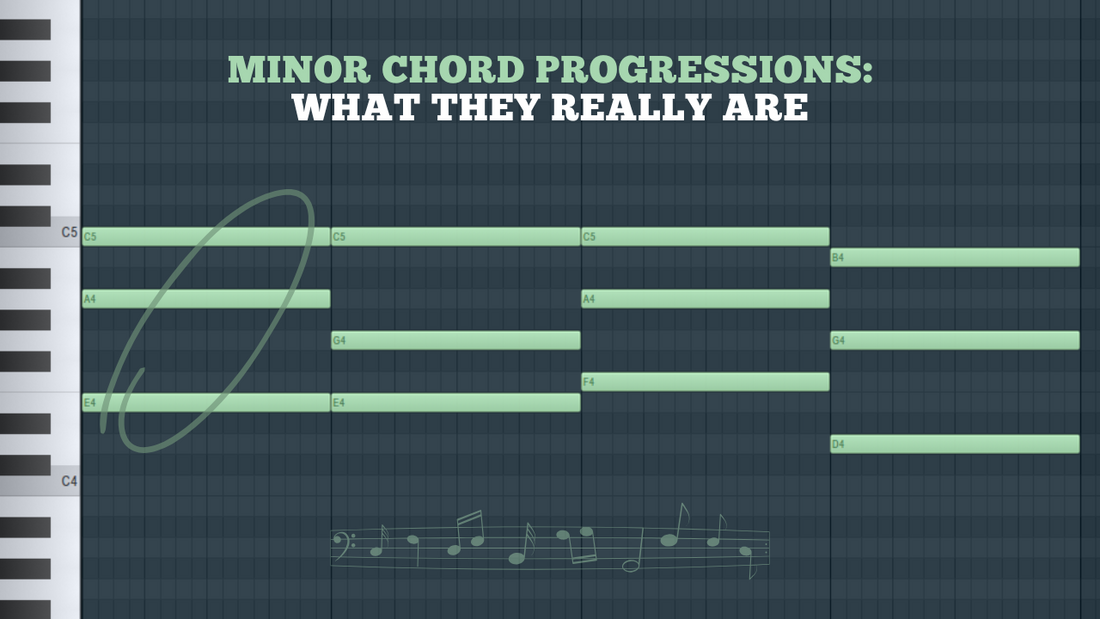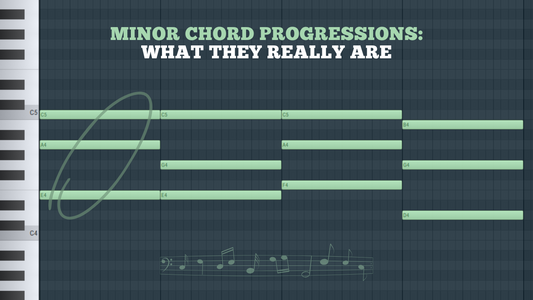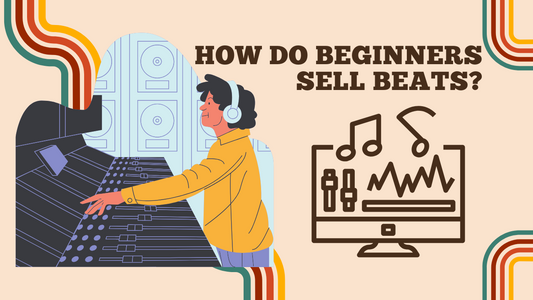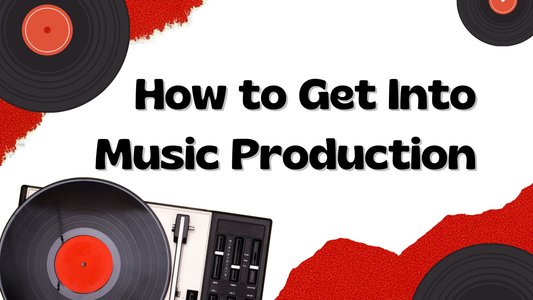
Minor Chord Progressions: Everything You Must Know to Create Emotional Music
Share
Minor Chord Progressions: What They Really Are
Minor chord progressions are sequences of chords built from minor keys that create emotional, moody, or dramatic feelings in music. They help producers and songwriters add depth, sadness, tension, or mystery to their songs, making the music feel more powerful and relatable.
As a music producer who's spent countless late nights tweaking tracks and chasing that perfect vibe, one thing has always stood out to me: minor chord progressions are pure magic. Whether you're crafting a melancholic ballad, a dark trap beat, or a cinematic score, minor progressions bring a depth of emotion that major chords just can't touch.
In this guide, I'll break down everything you need to know about minor chord progressions — from why they’re so powerful to real-world examples, practical techniques, and insider tips from years of production experience.
Why Minor Chord Progressions Hit So Hard
There’s something universal about the emotional pull of minor chords. Scientifically, they tend to evoke sadness, tension, or introspection. But as a producer, I’ve found that minor chord progressions can also feel intense, dramatic, mysterious, or even triumphant, depending on how you use them.
Minor keys tap into emotions that major keys can’t quite reach.
It’s why songs like “Someone Like You” by Adele or “Blinding Lights” by The Weeknd feel so deeply moving — even when they're not strictly "sad" songs.
Minor chord progressions aren't limited to ballads or emo tracks. They’re versatile tools that help you tell a richer musical story.
How Minor Chord Progressions Are Built
Before diving deeper, let's quickly look at how a minor scale is constructed:
-
Natural minor scale formula: W - H - W - W - H - W - W (W = whole step, H = half step)
For example, A minor scale:
A - B - C - D - E - F - G - (A)
Each degree of the scale creates a chord:
| Degree | Chord | Example in A Minor |
|---|---|---|
| i | minor | A minor |
| ii° | diminished | B diminished |
| III | major | C major |
| iv | minor | D minor |
| v | minor | E minor |
| VI | major | F major |
| VII | major | G major |
👉 Most minor chord progressions are built around these seven basic chords.
My Favorite Minor Chord Progressions (And When to Use Them)
Over the years, I've leaned on a few classic minor progressions that never fail to deliver emotion.
1. i - VI - III - VII
(Example in A minor: A minor - F major - C major - G major)
This is probably the most famous minor chord progression. It feels bittersweet — emotional yet uplifting.
Use it for: Pop ballads, anthemic choruses, lo-fi beats.
Songs like “Demons” by Imagine Dragons use this vibe to great effect.
2. i - iv - v
(Example: D minor - G minor - A minor)
A simple but powerful progression, perfect for raw, emotional tracks.
Use it for: Acoustic songs, singer-songwriter material, emotional movie scores.
Think of “Mad World” by Gary Jules — pure, haunting simplicity.
3. vi - IV - i - V
(Example: F# minor - D major - F# minor - C# major)
A modern twist that brings some dynamic energy without losing emotional depth.
Use it for: Trap beats, pop-punk, modern indie pop.
You hear flavors of this structure in artists like Juice WRLD or Post Malone.
4. i - VII - VI - VII
(Example: A minor - G major - F major - G major)
One of the classic progressions in rock, EDM, and even soundtrack music.
Use it for: Big, dramatic build-ups and cinematic energy.
A song like “Boulevard of Broken Dreams” by Green Day leans into this kind of dark, brooding vibe.
How to Spice Up Your Minor Chord Progressions
Once you’ve nailed the basics, it’s time to get creative!
Here are a few ways I like to keep my minor progressions feeling fresh:
1. Add 7th, 9th, or 11th Chords
A simple A minor chord sounds nice. But an A minor 7 (A - C - E - G) instantly feels more jazzy and emotional.
Example:
Try i7 - VI7 - III7 - VII7 instead of just basic triads.
2. Use Modal Interchange
Steal chords from other related keys.
For example, borrow a major IV chord (D major) in A minor to create unexpected color.
This is huge in genres like alternative pop, progressive rock, and cinematic scoring.
3. Play With Inversions and Voice Leading
Instead of jumping all over the keyboard, use inversions (same chord, different order of notes) to create smooth, flowing progressions.
This makes your chord changes feel more natural and professional.
Real-World Minor Chord Progression Examples
Let’s look at some famous songs and their minor progressions:
1.“Stay” – Rihanna feat. Mikky Ekko
Progression: C - G - Am - F
(Mostly major, but the A minor gives the whole song its emotional pull.)
2.“The Scientist” – Coldplay
Progression: Em - C - G - D
(Starts on minor, keeps the tension alive through the verse.)
3.“Lucid Dreams” – Juice WRLD
Progression: F# minor - D major - A major - E major
(Simple loop, heavy emotional punch.)
Notice how many hit songs live in minor progressions? It's not a coincidence.
How to Practice and Master Minor Chord Progressions
Here’s a simple 3-step method that helped me internalize minor progressions early on:
Step 1: Pick One Minor Key
Start with A minor (easy, no sharps or flats).
Step 2: Build Progressions Using the i, iv, v, VI, and VII chords
Play around. Feel the emotional difference when you swap a iv for a VI, or move from i to VII.
Step 3: Improvise Melodies On Top
Once you have a loop running, improvise simple melodies with the A minor scale notes.
This helps you feel where the emotion wants to go, not just think about it.
Additionally, you can experiment with your own minor chord progressions using our free online chord progression generator. It's a perfect tool to explore different genres and scales, helping you discover new and exciting combinations for your music. Whether you're a beginner or an experienced producer, the generator offers a quick and easy way to expand your creativity and find fresh sounds!
Why Minor Chord Progressions Are Essential for Every Producer
Whether you’re making lo-fi beats, trap bangers, or emotional singer-songwriter tracks, understanding how to build and feel minor chord progressions will massively level up your music.
It’s not just about "sounding sad" — it’s about creating real emotional impact.
And in today’s saturated music landscape, emotion is the real currency that gets you listeners, fans, and placements.
Once you master minor chord progressions, you’ll be able to:
-
Build tension and release naturally
-
Write more compelling toplines (melodies and vocals)
-
Arrange your songs with more dynamic emotional arcs
-
Stand out with music that actually moves people
Final Thoughts
Minor chord progressions are your best friend when it comes to making music that feels alive. Don’t be afraid to play, experiment, and let your ear guide you.
Some of my best tracks came from just sitting at the keyboard and following the emotions wherever they wanted to go.
Start simple.
Feel deeply.
And before you know it, you’ll be crafting songs that give people goosebumps.
Quick FAQ About Minor Chord Progressions
Q: Are minor chord progressions only for sad songs?
A: Nope! Minor chord progressions can express sadness, but they can also feel triumphant, mysterious, or empowering depending on how you use rhythm, instrumentation, and melody.
Q: What's the easiest minor key to start with?
A: A minor. It's simple, no sharps or flats, and feels very natural on piano or guitar.
Q: How do I make my minor chord progressions more interesting?
A: Experiment with 7th chords, modal interchange, inversions, rhythmic variations, and melody phrasing. Trust your ear and don't be afraid to break "rules."
What are some good minor chord progressions?
Some popular minor chord progressions include:
-
Am - F - C - G
-
Em - C - G - D
These progressions evoke emotion and are used in many hit songs. Experiment with them to find the right feel for your music.
What is the forbidden chord?
The "forbidden chord" usually refers to the tritone (an interval of three whole steps). It creates a dissonant sound and is traditionally avoided in classical music, though it’s used creatively in modern genres.
What's the saddest chord progression?
One of the saddest and most emotional minor chord progressions is Am - F - C - G. It creates a melancholic yet uplifting vibe, often heard in sad songs.
How to build minor chord progression?
To build a minor chord progression, start with the root minor chord, then move to related minor or major chords within the key. For example, in A minor, the progression could be Am - Dm - Em. Experiment with different combinations for unique results.
What chords complement A minor?
Chords that complement A minor include D minor (Dm), E minor (Em), and C major (C). You can also use G major (G) and F major (F) for added variety in your progression.






